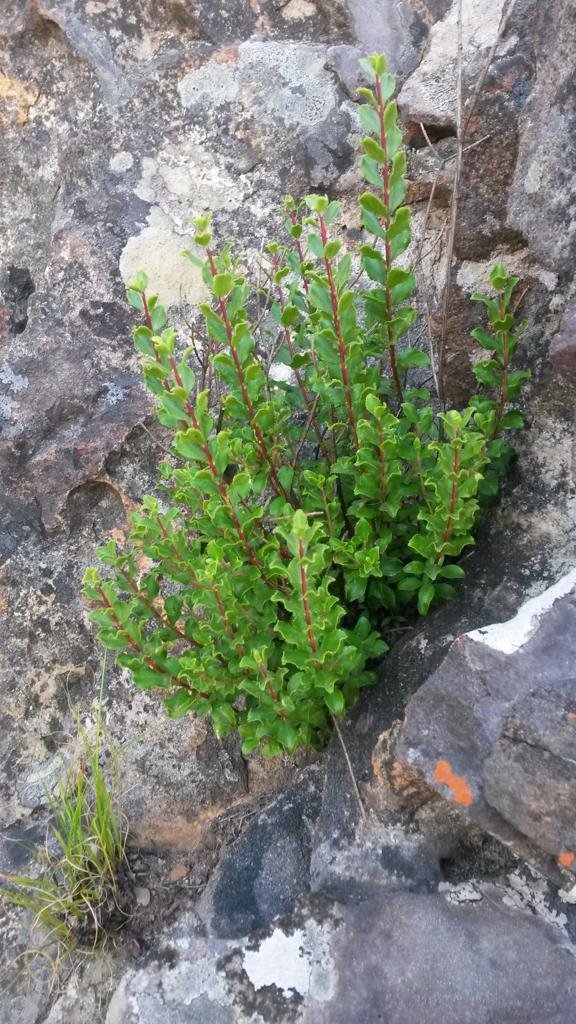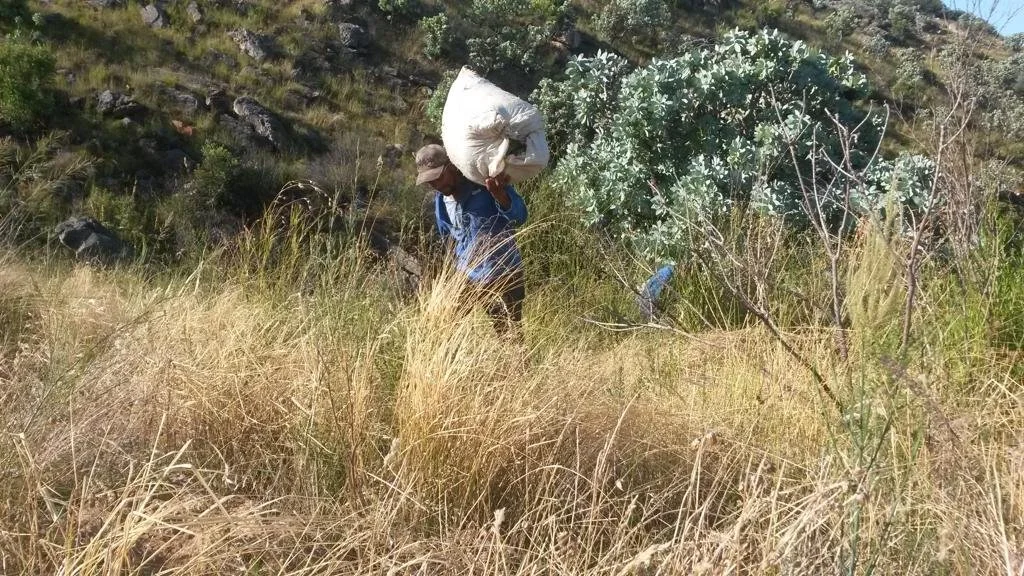Buchu (Agathosma spp)
Buchu cultivation landscape. (Photo: C. Baard)
by Cynthia Biddle Baard
Background
The use of buchu (Agathosma betulina, Agathosma crenulata) can be traced back hundreds of years to the local indigenous communities of the San and Khoi, while traditional wild harvesting is still practiced by their descendants in mountainous regions of the Western Cape, South Africa. Buchu leaves are distilled into an oil which is used topically and orally. Leaves are also used in tea but are primarily combined with other tea before being marketed (e.g. rooibos). The supply of buchu comes from both wild growing plants as well as cultivated farms. Wild harvesting has been documented in literature dating back to the 1820 (van Wyk & Prinsloo, 2018), while the first documentation of the propagation of buchu for cultivation dates to 1927 (Gentry, 1961). Some of the older buchu cultivators began in the 1960s (Piquet Buchu, 2022) though larger scale commercialisation only came to the fore in the late 1990s (van Wyk & Prinsloo, 2018; van Wyk, 2011). Threats to wild buchu include: prolonged drought periods, increased fire activity, agricultural expansion, and unsustainable harvesting practices.
Distribution
Buchu distribution in the wild is limited to the higher elevation mountain ranges of the Cape Fold Belt along the north-south running Cederberg Mountains from Clanwilliam south to Ceres (A. betulina) and along the east-west running Langeberg and Swartberg Mountains above the Olifants River valley (A. crenulata).
Wild buchu. (Photo: L. Chicken)
Conservation Methods
Methods of buchu conservation include encouragement of cultivation, product certification, a permitting system for harvesting, buying, and selling, and the promotion of land protection through stewardship programmes.
Protection
As a member of the fynbos family of plants, the protection of wild buchu populations plays a crucial role in the preservation of the Cape Floral Kingdom’s habitat biodiversity. Furthermore, its protection ensures sustainability of the industry by preserving genetic species diversity and resilience to threats from pests, parasites, climate change, and natural disasters.
Certification and Permitting
Certifications of both harvested and cultivated buchu play a role in ensuring product quality standards for the consumer. Encouraging a system of best practices and a code of conduct with the sustainability of the industry in mind discourages destructive harvesting practices and avoids over supply and contamination of products with other uncertified organic materials.
The Western Cape provincial government agency responsible for maintaining wilderness areas and public nature reserves is CapeNature. They conduct resource assessment processes and issue harvesting permits on a 3-yearly basis. Permits are required by private land owners wishing to harvest protected species on their land, as well as by those wishing to purchase or trade these species. There is no harvesting permitted in protected areas. The distribution of buchu is primarily within public and private nature reserves and along the mountainous areas owned by private commercial farmers adjacent to agricultural stands. In many cases, the mountainous sections of privately owned land are managed in stewardship with CapeNature which affords them some level of protection, however, monitoring of harvesting activities and methods proves challenging given the rugged terrain.
Organic cuchu cultivation. (Photo: C. Baard)
Cultivation
The earliest accounts of cultivation is from the Cederberg mountain region. In one documented case, a farmer in Clanwilliam in the northern section of the mountains began cultivating through a simple process of clearing other endemic fynbos plants and spreading wild seed along the stands. Maintenance of the plants consisted simply of weeding around the bushes and the plants were entirely rain-fed (Gentry, 1961). In the 1990s, as demand for product increased, so did a need for consistency in quantity and quality of supply, and wild harvests could not provide this. Due to this increased demand, prices began to rise so rapidly that potential buyers then began to consider alternatives threatening the industry itself. As a result, cultivation was promoted as an alternative to wild harvests where there was more control over volume and quality and where supply could be increased (Ntwana, 2007; Williams & Kepe, 2008). The rising costs of labour was another reason for the promotion of cultivation. As opposed to wild buchu, which is found sparsely dotted across the fynbos mountainside, the concentration of cultivated bushes allow for a faster harvesting process. In present day, cultivated species are irrigated throughout the summer (dry) season either through drip irrigation or overhead sprinklers to augment volumes produced.
Scientists have worked on soil composition analysis to provide optimisation for commercial cultivation operations (Ntwana, 2007). Modern chemical analyses have made it possible for scientists to determine the potency of active ingredients and to control for favourable features within cultivated varietals, setting forth a set of standards.
Buchu cultivation during harvesting. (Photo: L. Chicken)
This shift from wild harvested to cultivated stock has resulted in a majority of the supply coming from cultivated sources (van Wyk & Prinsloo, 2018; Xaba & Lucas, 2009). Cultivation of buchu remains localised to the areas where buchu is found naturally in the wild due to its demand for particular soil properties. Buchu plants are found at elevations above 500m, and grow in soils with low salinity, nitrate, and phosphate levels and prefer slightly acidic conditions (pH 3.5-4.5 but up to 5.5) (Department of Agriculture, Forestry and Fisheries, 2011). When found in the wild, their tolerance of potash and sulphur is higher than those growing in cultivated stands (Department of Agriculture, Forestry and Fisheries, 2011).
Local production volumes for buchu (and other essential oils) are not published or freely available and are notoriously difficult to determine other than through anecdotes from estimates provided by producers (Triumph Venture Capital, 2004).
Impact on Livelihoods
Local employment in the buchu industry is provided across many levels of the value chain from small-scale commercial cultivation operations and harvesting, distilleries, and through final product manufacturing of perfumes and medicinal products (Williams & Kepe, 2008). Unlike other indigenous species where plant distribution extends through inhabited valleys under community and communal ownership, buchu’s natural distribution itself limits the opportunities for community members to share in monetary benefits aside from entering the market through wild harvesting and small-scale non-irrigated cultivation operations if land ownership allows. Both wild and cultivated varietals require only seasonal harvesting (December through March) thus monetary benefits are limited for harvesters and are considered supplementary. Some commercial farms have expanded their operations to include in-house distilling and final product manufacturing to increase their profit margins and to provide more consistent year-round employment opportunities (Piquet Buchu, 2022).
Buchu haverster in cultivated field. (Photo: L. Chicken)
Land ownership plays an extensive role in terms of who serves to benefit from wild harvesting and small-scale cultivation operations. Endemic to the higher elevation mountainous regions, much of the land where buchu is found is protected. Of the private lands where buchu is found, much of it is on sections of undeveloped land owned by commercial and family-owned farming operations (citrus and other fynbos species (e.g. rooibos)).
In one community in the Cederberg region, Elandskloof, however, the establishment of a cultivated crop of buchu has been promoted as part of a poverty alleviation scheme (Williams & Kepe, 2008). This community is uniquely poised to farm buchu as it is located deep in a valley surrounded by the mountains where wild buchu crops grow. The over-promotion of buchu cultivation at the community level, however, is not wholly supported by the commercial farmers in the area as crop supplies risk being diluted with a threat of oversupply and resultant drop in prices (Williams & Kepe, 2008).
The final means for benefits arising from the buchu industry are for registered traditional knowledge (TK) holders who receive a percentage of profits from industry partners in accordance with the Bioprospecting, Access and Benefit Sharing Agreement (BABS) implemented through the National Environmental Management Act (NEMBA).
Click here to download a summary table of the case study.
References
Berliner, D., Clarke, J., McGregor, G. 2020. Principles for a Suitable Approach to a Long-term National Monitoring Programme that Considers Important Indigenous Bio-traded Species in South Africa and Regional Resource Assessment. Deutsche Gesellschaft für Internationale Zusammenarbeit (GIZ) GmbH; and The ABS Capacity Development Initiative (ABS Compliant Bio-trade in Southern Africa). Available here.
de Ponte M.M. 2003. Is buchu (Agathosma betulina) harvesting sustainable? Effects of current harvesting practices on biomass, reproduction and mortality. Master’s Thesis. University of Cape Town, South Africa. Available here.
Department of Agriculture, Forestry and Fisheries. 2011 Buchu Brochure. South Africa. Available here.
Gentry, H.S. 1961. Buchu, a New Cultivated Crop in South Africa. Economic Botany, 15(4):326-331.
Low, C. 2007. Different Histories of Buchu: Euro-American Appropriation of San and Khoekhoe Knowledge of Buchu Plants. Environment and History, 13(3):333-361. Available here.
Moolla, A. & Viljoen, A.M. 2008. 'Buchu' - Agathosma betulina and Agathosma crenulata (Rutaceae): A review. Journal of Ethnopharmacology, 110:413-419. Available here.
Muller, C. 2015. The Role Of Buchu (Agathosma betulina & Agathosma crenulata) Cultivation In Livelihoods And Conservation. Master’s Thesis. University of Cape Town, South Africa. Available here.
Ntwana, B. 2007. Growth, Mineral Content and Essential Oil Quality of Buchu (Agathosma Betulina) in Response to pH Under Controlled Conditions in Comparison with Plants from its Natural Habitat. Stellenbosch: University of Stellenbosch.
Piquet Buchu. Production. Available here.
South African National Biodiversity Institute (SANBI). 2003. Agathosma crenulata. Available here.
South African National Biodiversity Institute (SANBI). 2022. Red List of South African Plants. Agathosma betulina. Available here.
Triumph Venture Capital (Pty) Limited. 2004. Study into the Establishment of an Aroma and Frangrance Fine Chemicals Value Chain in South Africa: Aroma Chemicals Derived from Essential Oils. Part 4. Available here.
van Deventer, G., Bek, D. & Ashwell, A. 2016. Field Guide for Wild Flower Harvesting. Flower Valley Conservation Trust, South Africa. Available here.
van Wyk, A.S. & Prinsloo, G. 2018. Medicinal plant harvesting, sustainability and cultivation in South Africa. Biological Conservation, 227:335-342. Available here.
van Wyk, B.E. 2011. The potential of South African plants in the development of new medicinal products. South African Journal of Botany, 77(4):812-829. Available here.
Williams, S. & Kepe, T. 2008. Discordant Harvest: Debating the Harvesting and Commercialization of Wiild Buchu (Agathosma betulina) in Elandskloof, South Africa. Mountain Research and Development. 28(1):58-64.
Xaba, P.X. & Lucas, N. 2009. Buchu. Veld & Flora, 95(3):160-161. Available here.





